China Railway Construction Bundle
Can CRCC Maintain Its Dominance in the Global Infrastructure Race?
China Railway Construction Company (CRCC) is a global powerhouse, but what does its China Railway Construction SWOT Analysis reveal about its position in the competitive landscape? From its roots as a military engineering unit to its current status as a publicly traded giant, CRCC has consistently shaped the infrastructure of China and beyond. Understanding CRCC's competitive environment is crucial for anyone tracking the railway construction market and the broader infrastructure projects China is undertaking.
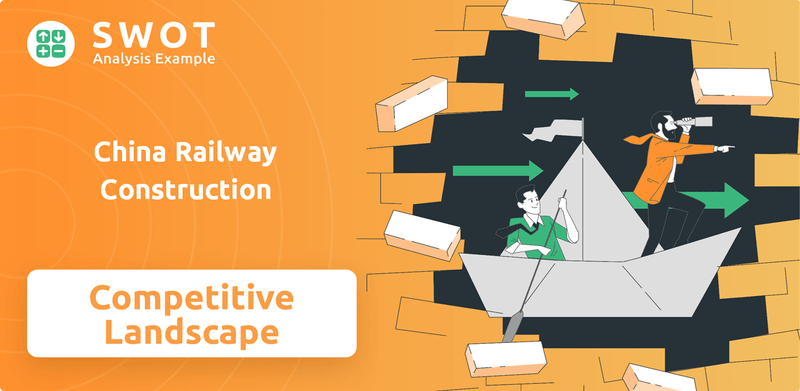
This exploration of CRCC's competitive landscape will dissect its market share analysis, identify key China Railway Construction Company competitors, and assess its financial performance. We'll also examine CRCC's major projects, including those in Africa, and delve into how CRCC wins contracts. Furthermore, we will explore the future of railway construction in China and the impact of the Belt and Road Initiative on CRCC, providing insights into its international expansion strategy and the challenges it faces.
Where Does China Railway Construction’ Stand in the Current Market?
China Railway Construction Corporation Limited (CRCC) holds a significant position in the global infrastructure construction sector, with a strong presence in China and growing international operations. As of 2023, CRCC was ranked 43rd on the Fortune Global 500 list, highlighting its substantial scale and influence within the industry. The company is a leading integrated construction group, involved in infrastructure projects such as railways, highways, bridges, and urban rail transit, as well as related services like survey, design, manufacturing, real estate development, and logistics.
CRCC's market position is particularly strong in the railway construction market in China, where, along with China Railway Group Limited (CREC), it has a dominant share. The company's operations span across all of China's provinces, and it has expanded its international footprint to over 100 countries and regions, including key markets in Africa, Asia, and Latin America. CRCC primarily serves government entities for large-scale public infrastructure projects and private developers for real estate and other construction ventures.
Financially, CRCC's scale is immense. For the first three quarters of 2023, the company reported a total revenue of approximately RMB 860.076 billion (around USD 120 billion), demonstrating its robust financial health. This financial strength allows CRCC to undertake large-scale projects, providing a competitive edge in terms of project capacity and financial backing. This is a key factor in the Growth Strategy of China Railway Construction, as it continues to expand its international presence and diversify its revenue streams.
CRCC, along with CREC, holds a dominant position in China's railway construction market. While specific up-to-date market share figures for 2024-2025 are not readily available in the provided snippets, their duopoly in the domestic railway sector is well-established.
CRCC has strategically expanded its international presence, diversifying its revenue streams and seeking growth opportunities in emerging markets. This move towards a more globally balanced positioning is a key aspect of their strategic growth.
For the first three quarters of 2023, CRCC reported a total revenue of approximately RMB 860.076 billion (around USD 120 billion). This robust financial performance showcases the company's strong position and ability to undertake large-scale projects.
CRCC's financial strength allows it to undertake mega-projects that few other companies can. This provides a significant competitive edge in terms of project capacity and financial backing compared to many industry averages.
The competitive landscape for China Railway Construction Company (CRCC) involves a mix of domestic and international players. CRCC's dominance in the railway construction market, coupled with its significant presence in infrastructure projects, positions it as a key player in the industry.
- CRCC's strong financial backing and project capacity give it a competitive edge.
- The company's international expansion strategy focuses on diversifying revenue streams.
- CRCC primarily serves government entities for large-scale public infrastructure projects.
- CRCC's market share, especially in railway construction, is a key indicator of its influence.
China Railway Construction SWOT Analysis
- Complete SWOT Breakdown
- Fully Customizable
- Editable in Excel & Word
- Professional Formatting
- Investor-Ready Format
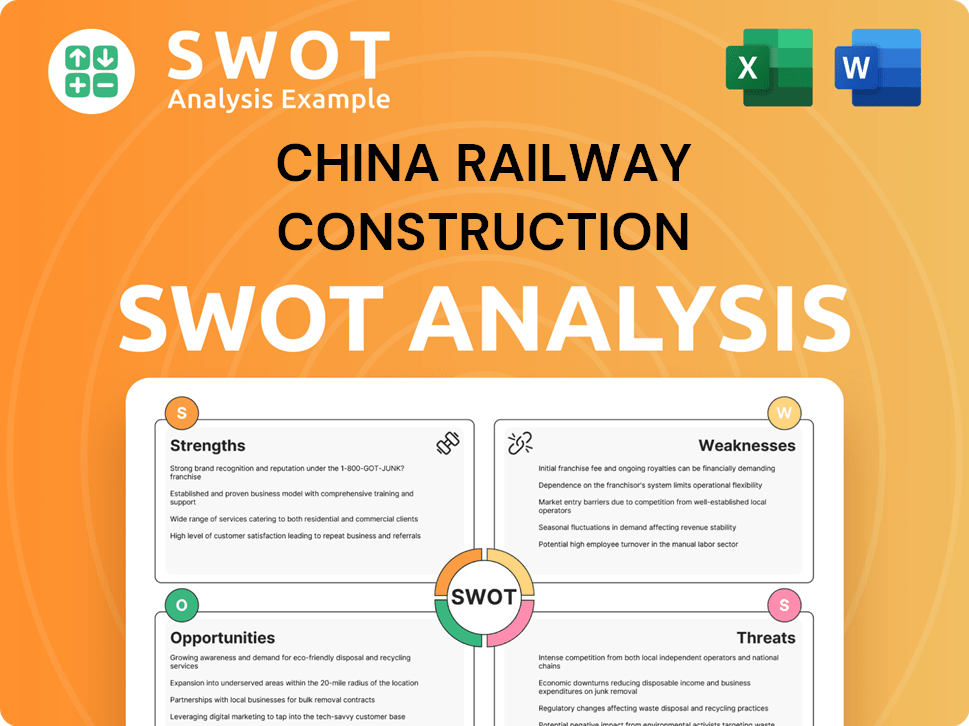
Who Are the Main Competitors Challenging China Railway Construction?
The Competitive landscape for China Railway Construction Company (CRCC) is shaped by a mix of domestic and international players. CRCC operates primarily within the railway construction market, but also engages in a broad range of infrastructure projects, making its competitive environment quite dynamic. Understanding the key competitors is crucial for assessing CRCC's position and future prospects, including its financial performance and expansion strategies.
CRCC faces competition from both state-owned enterprises (SOEs) and international firms. The nature of its projects, including China's railway infrastructure development and international ventures, influences the competitive dynamics. The CRCC market share analysis and its ability to secure contracts are directly impacted by these competitors, making it essential to understand their strengths and strategies.
The primary rivalry for CRCC lies within China's construction sector. The most significant competitor is China Railway Group Limited (CREC), often considered its counterpart and a key player in the railway construction market. Both companies are massive SOEs with extensive experience in infrastructure projects, competing directly for major domestic and international contracts. The competition between CRCC and CREC frequently involves bidding wars for high-profile projects, leveraging their vast resources and government backing. For further insights, consider exploring the Growth Strategy of China Railway Construction.
CREC is a direct competitor to CRCC, often considered its primary rival within the Chinese construction market. Both companies compete for similar infrastructure projects, including railways, highways, and bridges.
CCCC specializes in transportation infrastructure, particularly ports, roads, and bridges. CCCC's diversified portfolio often leads to direct competition with CRCC in various infrastructure segments.
CSCEC is a global leader in building construction and real estate. While its primary focus differs, CSCEC competes with CRCC in urban development and international projects.
This South Korean firm competes with CRCC in the international arena, particularly in high-speed rail and complex infrastructure projects. They often bring advanced technologies and specialized project management.
Vinci S.A. is a major global construction company from Europe. They compete with CRCC in international markets, especially in projects where technological expertise is paramount.
ACS Group is a Spanish construction company that competes with CRCC in the international arena. They are often involved in large-scale infrastructure projects.
In the international arena, CRCC faces competition from major global construction companies. These include firms from South Korea, Europe, and Japan. The competitive dynamics also include emerging players from developing countries who are gaining expertise and seeking to expand their global footprint, particularly in regions targeted by China's Belt and Road Initiative. These international competitors often challenge CRCC through advanced technologies, specialized project management, and strong local partnerships.
CRCC's ability to compete effectively hinges on several factors, including its financial performance, bidding process, and project management capabilities. The company's success is also influenced by the impact of the Belt and Road Initiative and its international expansion strategy.
- Government Support: Being a state-owned enterprise, CRCC benefits from government backing, which provides access to financing and preferential treatment in domestic projects.
- Project Expertise: CRCC's extensive experience in railway construction and other infrastructure projects gives it a competitive edge.
- Technological Capabilities: The company's ability to adopt and implement advanced technologies is crucial, especially in high-speed rail projects.
- Financial Resources: CRCC's strong financial position enables it to undertake large-scale projects and compete effectively.
- International Partnerships: Forming alliances and partnerships with local firms in international markets can enhance CRCC's competitiveness.
China Railway Construction PESTLE Analysis
- Covers All 6 PESTLE Categories
- No Research Needed – Save Hours of Work
- Built by Experts, Trusted by Consultants
- Instant Download, Ready to Use
- 100% Editable, Fully Customizable
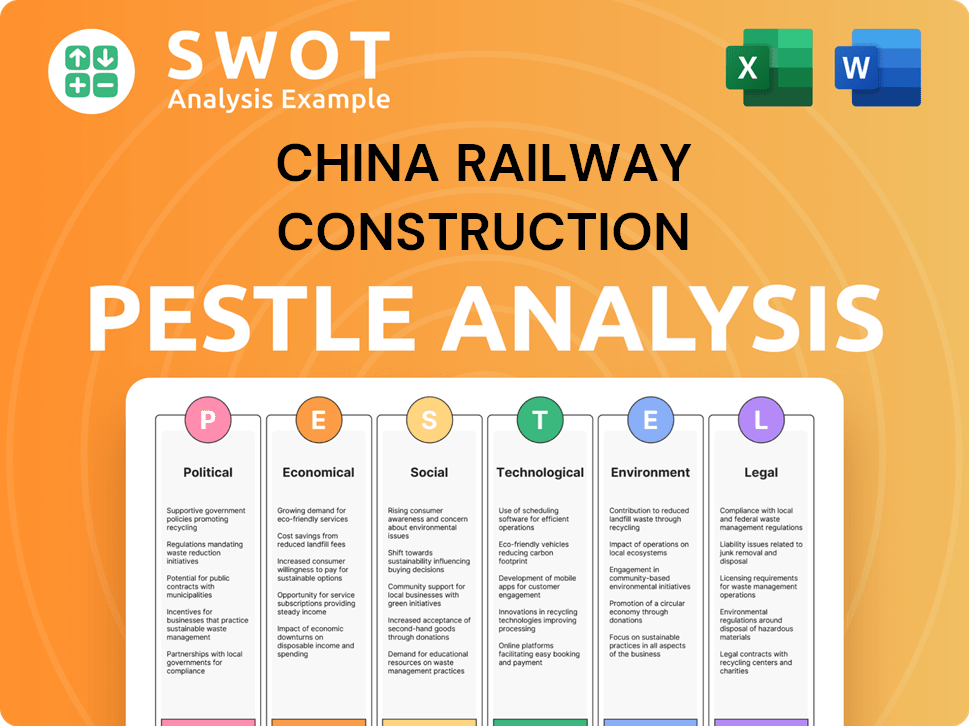
What Gives China Railway Construction a Competitive Edge Over Its Rivals?
The China Railway Construction Company (CRCC) stands out in the competitive landscape due to its significant advantages. CRCC's success is built on its massive scale, vast resources, and deep expertise, particularly in railway construction. This allows it to undertake large-scale projects that many competitors cannot handle, solidifying its position in the railway construction market.
CRCC's competitive edge is further enhanced by its strong backing from the Chinese government, which provides preferential access to financing and strategic support for international expansion, especially through initiatives like the Belt and Road Initiative. The company's established brand equity also fosters trust and credibility with clients worldwide. For anyone interested in learning more about how CRCC operates, a look at the Marketing Strategy of China Railway Construction can provide valuable insights.
CRCC's ability to secure and execute large-scale infrastructure projects, combined with its technological capabilities and government support, positions it as a formidable player. While specific financial figures for 2025 are unavailable, the company's historical performance and strategic positioning suggest continued dominance in the sector. However, CRCC faces potential challenges from global scrutiny, intellectual property concerns, and rapid technological advancements from international competitors.
CRCC is one of the world's largest construction groups, allowing it to handle mega-projects. This includes vast financial resources, a large equipment fleet, and a massive workforce. This scale provides a significant barrier to entry for smaller or less diversified Chinese construction companies.
CRCC has extensive experience in railway construction, including high-speed rail, tunnels, and bridges. This expertise includes proprietary technologies and intellectual property. CRCC's technological leadership is evident in its involvement in pioneering projects.
CRCC benefits from strong backing by the Chinese government, including preferential financing. Strategic support for international expansion, especially through the Belt and Road Initiative, is also a key advantage. This support enables CRCC's global ambitions.
CRCC has built a strong brand reputation over decades of successful project delivery. This fosters trust and credibility with clients worldwide. This established brand equity is a key factor in securing contracts and maintaining a competitive edge.
CRCC's competitive advantages include its scale, technological expertise, and government support. These strengths allow it to undertake complex infrastructure projects and expand globally. While specific 2024-2025 financial data is unavailable, CRCC's strategic positioning suggests continued dominance.
- Immense scale and comprehensive capabilities.
- Deep expertise and technological prowess.
- Strong backing by the Chinese government.
- Established brand equity and global trust.
China Railway Construction Business Model Canvas
- Complete 9-Block Business Model Canvas
- Effortlessly Communicate Your Business Strategy
- Investor-Ready BMC Format
- 100% Editable and Customizable
- Clear and Structured Layout
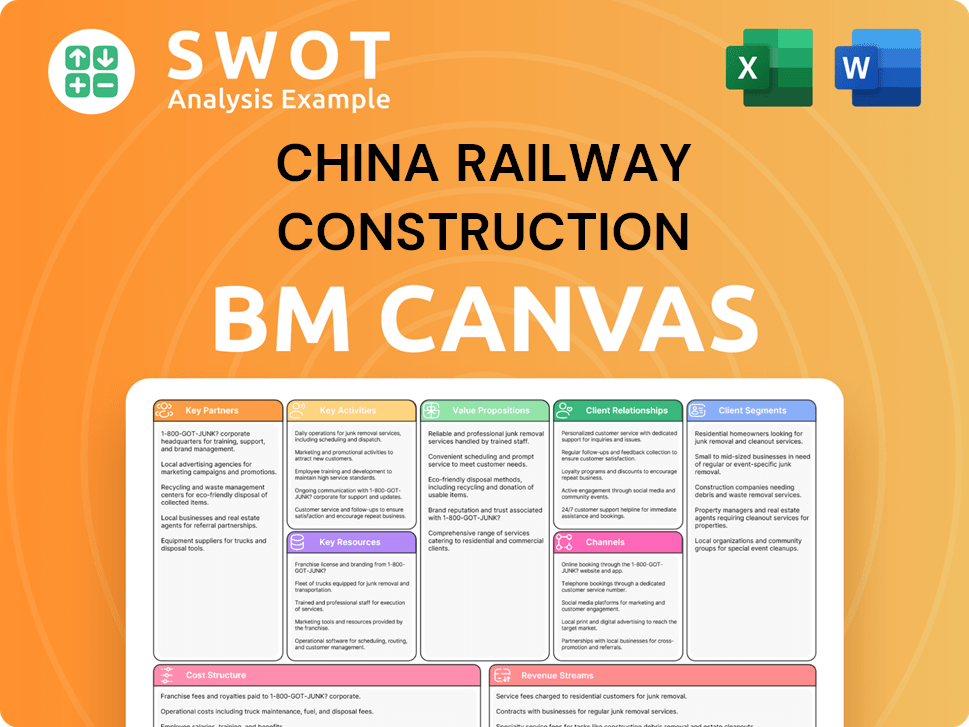
What Industry Trends Are Reshaping China Railway Construction’s Competitive Landscape?
The China Railway Construction Company (CRCC) operates within a dynamic global construction industry, influenced by trends such as sustainability and technological advancements. Understanding the competitive landscape is crucial for evaluating CRCC's position, which includes analyzing its market share, financial performance, and strategic initiatives. The company faces challenges related to geopolitical risks and fluctuating costs, while also having opportunities in expanding service offerings and international partnerships.
CRCC's future outlook depends on its ability to adapt to evolving market demands and manage risks effectively. This involves strengthening technological capabilities, enhancing risk management, and exploring new financing models. For a deeper dive into CRCC's business operations, consider exploring the Revenue Streams & Business Model of China Railway Construction.
The construction industry sees increasing demand for sustainable and green infrastructure, as governments prioritize environmentally friendly practices. Technological advancements like BIM and AI are revolutionizing construction, offering increased efficiency. The 'Belt and Road Initiative' continues to be a major driver for infrastructure projects, particularly in emerging markets.
CRCC faces challenges from increased geopolitical tensions, which can affect project approvals and financing. Fluctuating raw material prices and labor costs could impact profitability. Heightened scrutiny over debt sustainability in some developing nations poses additional risks. Competition from local and international firms is intense.
CRCC can diversify its service offerings, including digital infrastructure and smart transportation systems. Strategic partnerships with local companies in international markets can help mitigate risks and enhance market penetration. Expanding into urban renewal projects presents additional growth opportunities.
CRCC will likely focus on strengthening its technological capabilities and enhancing risk management for international projects. Exploring new financing models is essential to adapt to the evolving competitive landscape. The company must navigate geopolitical risks while expanding its global footprint.
To remain competitive, CRCC must navigate industry trends, future challenges, and strategic opportunities. The company's ability to adapt to technological advancements, manage geopolitical risks, and expand its service offerings will be crucial for its long-term success. Understanding the CRCC market share analysis and the competitive landscape is essential.
- Technological Integration: Adoption of BIM, AI, and robotics.
- Risk Management: Mitigating geopolitical and financial risks.
- Market Diversification: Expanding into new service areas.
- Strategic Partnerships: Collaborating with local and international firms.
China Railway Construction Porter's Five Forces Analysis
- Covers All 5 Competitive Forces in Detail
- Structured for Consultants, Students, and Founders
- 100% Editable in Microsoft Word & Excel
- Instant Digital Download – Use Immediately
- Compatible with Mac & PC – Fully Unlocked
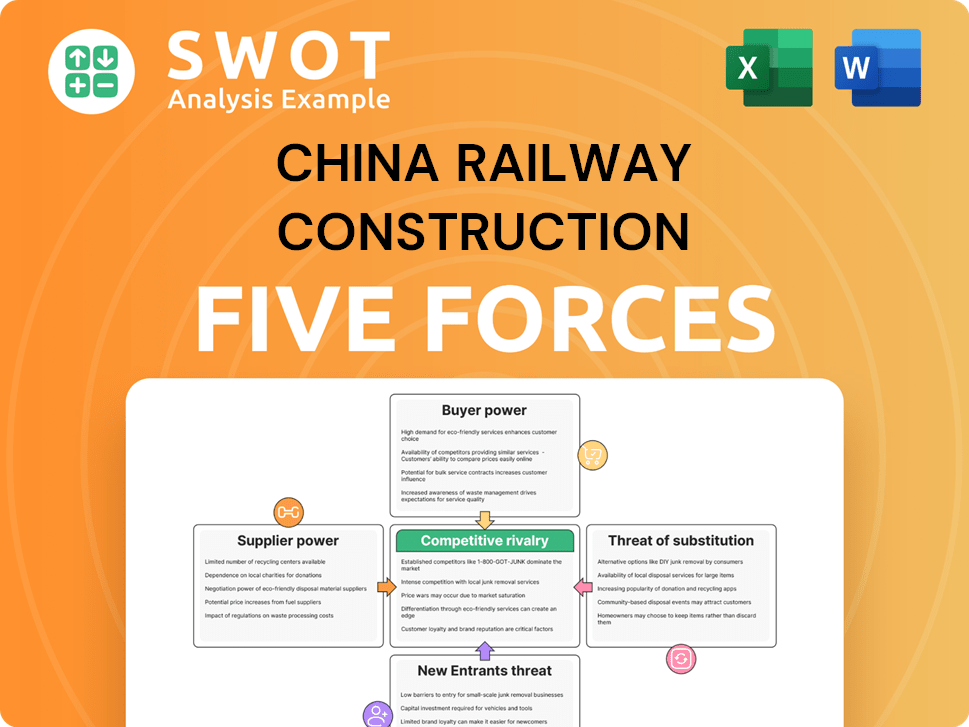
Related Blogs
- What are Mission Vision & Core Values of China Railway Construction Company?
- What is Growth Strategy and Future Prospects of China Railway Construction Company?
- How Does China Railway Construction Company Work?
- What is Sales and Marketing Strategy of China Railway Construction Company?
- What is Brief History of China Railway Construction Company?
- Who Owns China Railway Construction Company?
- What is Customer Demographics and Target Market of China Railway Construction Company?
Disclaimer
All information, articles, and product details provided on this website are for general informational and educational purposes only. We do not claim any ownership over, nor do we intend to infringe upon, any trademarks, copyrights, logos, brand names, or other intellectual property mentioned or depicted on this site. Such intellectual property remains the property of its respective owners, and any references here are made solely for identification or informational purposes, without implying any affiliation, endorsement, or partnership.
We make no representations or warranties, express or implied, regarding the accuracy, completeness, or suitability of any content or products presented. Nothing on this website should be construed as legal, tax, investment, financial, medical, or other professional advice. In addition, no part of this site—including articles or product references—constitutes a solicitation, recommendation, endorsement, advertisement, or offer to buy or sell any securities, franchises, or other financial instruments, particularly in jurisdictions where such activity would be unlawful.
All content is of a general nature and may not address the specific circumstances of any individual or entity. It is not a substitute for professional advice or services. Any actions you take based on the information provided here are strictly at your own risk. You accept full responsibility for any decisions or outcomes arising from your use of this website and agree to release us from any liability in connection with your use of, or reliance upon, the content or products found herein.